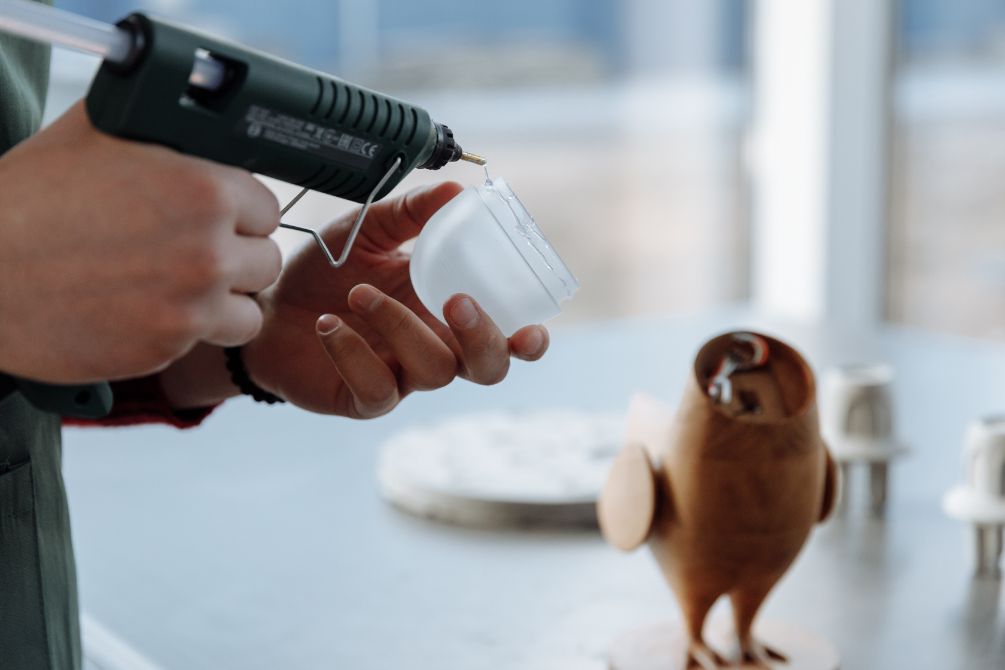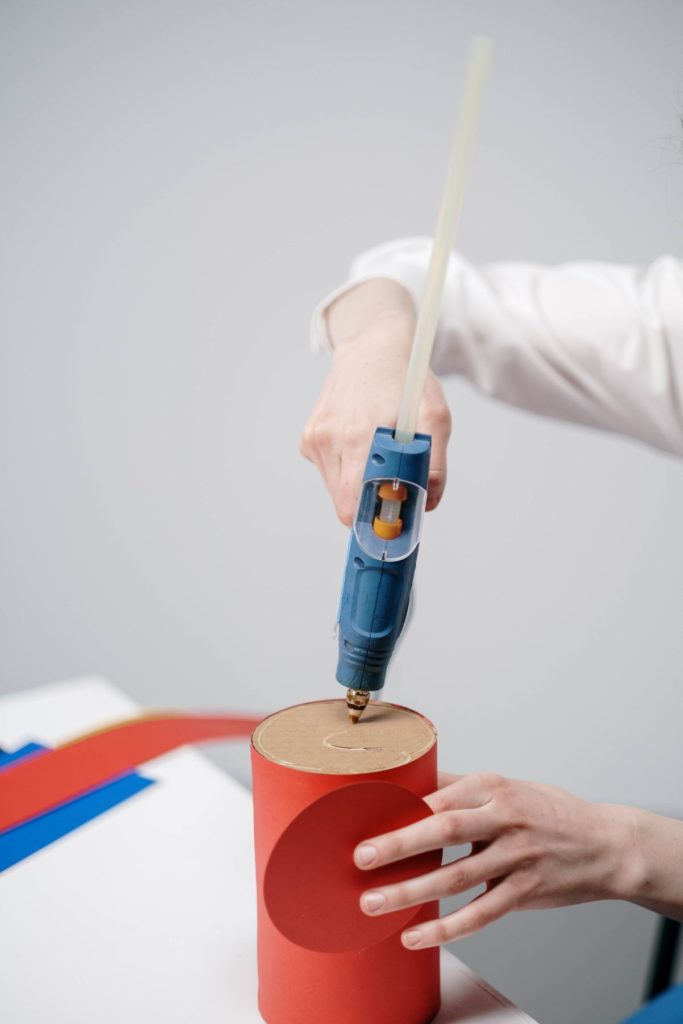UV glue is an adhesive used to bond materials by applying ultraviolet light. The main ingredient in UV glue is cyanoacrylate. UV glue is a type of adhesive that uses ultraviolet light to dry. It comes in either a tube or pen form for easy application.
It’s prominently used by crafters but can also be used for household repairs. However, sometimes the UV glue becomes sticky, disallowing it from curing properly. This problem is known as peeling. So, what causes UV glue to peel?
Are you looking for the causes that make UV glue peel? If yes, this article will tell you what causes UV glue to peel.
Contents
- 1 20 Causes Of UV Glue Peeling
- 1.1 1. UV Light Exposure
- 1.2 2. Not Enough UV Light Exposure
- 1.3 3. Improper Application
- 1.4 4 . Not Using The Right Glue
- 1.5 5. Not Heating The Bottle Of Glue Properly
- 1.6 6. Not Measuring The Proper Amount Of Glue
- 1.7 7. Spraying Too Closely
- 1.8 8. Not Preparing The Glue Bottle Properly
- 1.9 9. Not Heating The Area To Apply The Glue
- 1.10 10. Not Wiping Away The Residue
- 1.11 11. Using The Glue-On Tacky Surfaces
- 1.12 12. Not Curing The Glue
- 1.13 13. Using A Cheap Bottle Of Glue
- 1.14 14 . Not Working In The Right Environment
- 1.15 15 . Not Testing The Glue
- 1.16 16 . Applying The Glue-On Wet Surfaces
- 1.17 17.Using Too Much Resin
- 1.18 18 . Letting The Resin Dry Before Application
- 1.19 19 . Not Understanding The Instructions On The Bottle
- 1.20 20. Applying The Glue In Cold Temperatures
- 2 Benefits Of UV Glue Peeling
- 3 UV Glue Peeling Paint, Fabric, Plastic, Paper, Wood & More
- 4 What Causes UV Glue To Peel – Conclusion
20 Causes Of UV Glue Peeling
UV glue, also known as resin accelerator, cures when exposed to ultraviolet light. If the UV glue is not fully dried it may peel after application or days later. Here are some things that can cause UV glue to peel.
1. UV Light Exposure
The main cause of glue peeling is exposure to ultraviolet light. Even though it dries very quickly, there are times when the crafter doesn’t notice that they are still exposing the glue to the sun or any bright light source for too long. This can result in peeling.
2. Not Enough UV Light Exposure
Another cause of glue peeling is when the crafter only has their hands exposed to the light, but not enough of it. This can lead to incomplete curing and an increase in tackiness which leads to glue peeling over time.
3. Improper Application
Glue peeling may also occur if you don’t allow it to cure for 24 hours before use. It’s also a good idea to avoid touching the exposed area of the glue because oil from your skin can slow down or prevent curing from occurring properly.
4 . Not Using The Right Glue
UV glue has many uses but may not be suitable for all surfaces. For example, it’s not a good idea to use it on fabrics like silk because it can ruin the material. Always make sure you’re using the right glue for your project before applying.
5. Not Heating The Bottle Of Glue Properly
Before you use the glue, make sure that it’s heated properly by rotating the bottle several times and shaking it up and down. This way, when you spray it, the glue will have the correct consistency.
6. Not Measuring The Proper Amount Of Glue
You should only use a drop of UV glue at a time because if you spray too much, then it can peel or cause an uneven surface on your project. Spraying in short bursts will also help reduce the risk of accidentally peeling the glue later on.
7. Spraying Too Closely
UV light can cure glues within 5 to 10 seconds, but if you spray too close then the glue will dry before it has time to harden. This can cause it to peel or not set correctly. Make sure that all surfaces are clean and there is no dirt or debris present before spraying.
8. Not Preparing The Glue Bottle Properly
It’s very important that you properly prepare the glue bottle before using it so that if any clogs occur, they can be easily fixed with a pin or needle. If there are any bubbles in the mixture, then you should turn the bottle upside down and spray a few times to get the air bubbles to rise. After, spray in short bursts until all air bubbles disappear.
9. Not Heating The Area To Apply The Glue
UV glue generally needs temperatures between 30 and 50 degrees Celsius (86 and 126 degrees Fahrenheit) to set properly. If you don’t use it in an area with high enough temperatures, then the glue may not set correctly or peel off later on.
10. Not Wiping Away The Residue
After using or storing the glue, you should wipe it away with a dry cloth so that any excess resin can be removed. This will prevent clogging issues. If there are any areas where residue remains, then it can cause peeling later on.
11. Using The Glue-On Tacky Surfaces
Moisture or tacky surfaces like playground equipment may not be suitable for UV glue. If you do use it in these areas, there is a high chance that the glue will peel off after application. Stick to using it in dry areas with proper lighting.
12. Not Curing The Glue
You mustn’t touch the surface of your glue for at least 24 hours after application to allow it to cure properly. If the glue is not cured, then it may peel off later on or become too tacky.
13. Using A Cheap Bottle Of Glue
Another cause of glue peeling is when the crafter uses a cheap bottle of glue because it may not contain enough resin. The more resin in the bottle, the better and longer-lasting the bond will be after application.
It’s also useful to use a glue gun that contains ceramic tips or heating elements instead of metal ones because metal ones can lower the temperature and prevent the resin from curing properly.
14 . Not Working In The Right Environment
Another factor that can increase your chance of glue peeling is working in the wrong environment. UV glue requires certain conditions like good lighting and room temperature to set correctly, so you should avoid applying it if these conditions aren’t ideal.
15 . Not Testing The Glue
UV glue can be applied directly to most surfaces, but if you’re using a new brand of resin, it’s a good idea to test it out on a small area first before doing your whole project. This way, you can make sure that the glue is suitable for your surface and won’t peel off later on.
16 . Applying The Glue-On Wet Surfaces
Water or moisture may cause the glue to peel because it seeps into cracks and small holes in the surfaces, causing weak spots. Make sure that all surfaces are free of water before applying the UV glue to prevent this from happening.
17.Using Too Much Resin
You must apply the UV glue correctly by adding it to a clean surface with a brush, in short, controlled strokes. If you add too much resin onto the surface then it can overflow and seep into cracks or holes that were not intended for the resin.
18 . Letting The Resin Dry Before Application
If you let the resin dry before application, it will be very difficult to work with and may peel off later on. You should always apply resin immediately after spraying it onto a surface for best results.
19 . Not Understanding The Instructions On The Bottle
When you open the bottle of UV glue for the first time, read through the instructions carefully to make sure that you understand how it should be used. If you don’t prepare correctly before application, then it may not be set properly and could peel off later on.
If there are any questions or concerns while reading the instructions, it’s important to consult the company’s customer service hotline or website.
20. Applying The Glue In Cold Temperatures
The lower the room temperature is, the higher your chance of resin peeling off later on. If you need to do a lot of work in cold weather, make sure that you take frequent breaks and warm up your glue gun between uses.
Benefits Of UV Glue Peeling
There are many benefits of UV glue peeling. So, let’s look at them.
1. Allows For Easy Removal
There are times when you accidentally get the glue on a surface that you didn’t want it on. In such situations, it’s easy to remove because most of the time, all you have to do is peel off the dried glue.
2 . Makes It Easier To Apply
UV glue takes an average of 10 seconds to cure. This quick curing time allows the crafter to apply and remove as many times as they want or need to. This makes it easier for them to get the result that they desire without having to worry about making a mistake and not being able to fix it.
3. More Accurate
When you’re working on a detailed or delicate project, you must be able to get the glue where you need it and avoid placing it in another area. This can be difficult with some glues because of their thick consistency and slow-drying formula. However, UV glue dries very quickly, allowing for more accurate placement.
Reference Video – Everything You Need To Use UV Curing Adhesive
4. Easier Cleanup

Since UV glue dries so quickly, it’s easy to clean up any mess because you won’t have much time before it hardens. You can simply scrape off the dried glue once it has been cured and disposed of properly or use it for another project later on.
5. Prevents Accidental Bonding

There are also times when you want to apply the glue to one thing but it accidentally gets on something else, like your skin or certain fabrics. If that happens, then all you have to do is peel off the dried glue for easy removal.
You won’t have to worry about using any harsh chemicals so it’s great for kids who are learning how to use UV glue.
6 . Allows For Reuse
If you find that you don’t use all of the glue or if it becomes dry, then all you have to do is peel it off and save it for later. This allows for reuse when needed without having to go out and buy more products.
UV Glue Peeling Paint, Fabric, Plastic, Paper, Wood & More
1. What Causes UV Glue To Peel Paint
The most common reason for peeling paint is that the work or object was not properly prepped before application. This means you should prepare the surface, clean off any dirt or debris with a cloth, and let it dry completely.
You should also read the instructions on your paint bottle to see if they have any additional tips or suggestions on how you should prepare the surface.
2 . What Causes UV Glue To Peel Fabric
When you’re working with fabric and UV glue, the most common cause of peeling is not letting it dry properly before application. You should always prepare surfaces by cleaning off any dirt or dust and letting them dry completely before adding the adhesive.
If you notice that your textiles are peeling after several hours, it might be because they were not allowed to dry completely before they were applied, so make sure you give them time to acclimate.
3 . What Causes UV Glue To Peel Plastic
One of the most common reasons for peeling plastic is that it wasn’t allowed to dry fully before application. If you notice your plastics are sticking together and peeling off, give them more time to dry. Another possible cause of this is not allowing the resin to cure long enough before applying additional coats.
4 . What Causes UV Glue To Peel Paper
When you’re working with paper and UV glue, peeling may occur if the paper was not clean before application. Text and images printed on paper can sometimes transfer to itself when it’s under pressure, which may cause it to peel later on.
If this is the case, make sure that the surface of your paper is clean and free from any debris or dirt.
5 . What Causes UV Glue To Peel Wood
One of the most common causes of peeling wood is that too much resin was applied onto the surface before it could dry properly. If you notice that your glue is still wet after several hours, give it additional time to set completely before continuing with your project. Additionally, if the wood has any moisture in it before application, you might see peeling later on.
What Causes UV Glue To Peel – Conclusion
As you can see, the most common reason for UV glue to peel is that it was not allowed to dry before application. It’s also important that you read through the instructions on your paint bottle or resin carefully to make sure that you understand everything fully before applying it to your surface. This will help prevent any peeling problems later on.
References
- https://www.chemical-concepts.com/blog/2018/12/uv-adhesives-whats-deal/
- https://www.gadgetdetail.com/the-truth-behind-uv-tempered-glass/
- https://www.melo2.com/blogs/stationery/uv-glue

I fell in love with crafts & fixing things when I was 11 years old – after discovering the world of blogging, I am combining my passions to present the world with well-researched guides & reviews about everything related to adhesives & glue.